Hydraulic Principles and Applications for HND Construction and the Built Environment at The UCK London College
Added on 2023-06-15
37 Pages5910 Words288 Views
The UCK London College
[HNCB 038] Hydraulic Principles and Applications
By
Imran Kaisor
Module leader: T. Frank
HND Construction and the Built Environment
Department of Engineering
The UCK London College
[HNCB 038] Hydraulic Principles and Applications
By
Imran Kaisor
Module leader: T. Frank
HND Construction and the Built Environment
Department of Engineering
The UCK London College
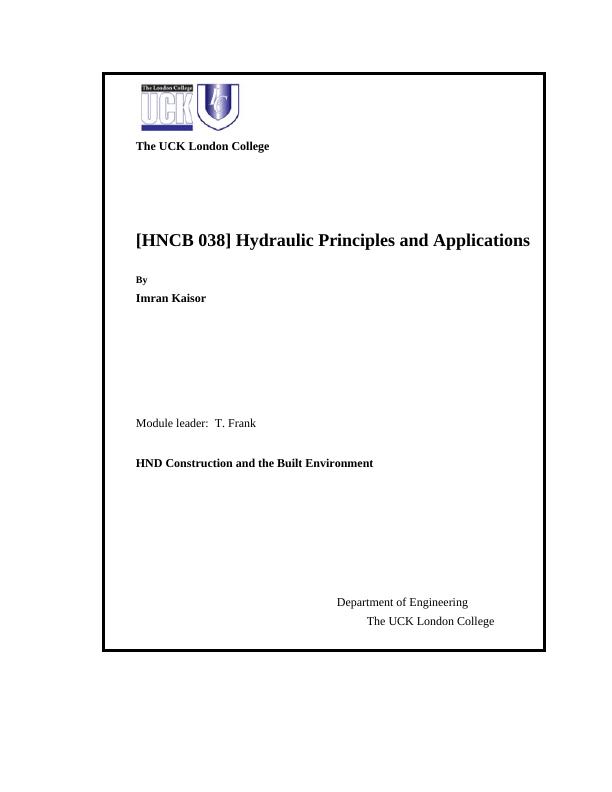
LO1. Be able to solve engineering hydrostatic problems.
1.1 Pressure measuring devices
1.2 Hydrostatic forces
LO2. Be able to solve engineering flow problems.
2.1 Carry out calculations for pipeline flow problems.
2.2 carry out calculations for open channel flow problems
2.3 Analytical principles
2.4 Closed conduit flow
2.5 Uniform open channel flow
2.6 Flow measurement in open channels
LO3. Be able to match pumps to the demands of a specific system.
3.1 Pump matching: energy and hydraulic gradients in pump-pipeline systems;
pump performance and characteristic curves; pump selection to operate in a
given system; pumps in series and parallel
3.2 Specific systems: hydrodynamic machines; classification of pumps and turbines
(radial, axial, reaction)
LO4. Be able to undertake hydraulic experimental procedures
4.1 You have participated in a number of different experiments in the hydraulics
lab. Undertake brief reports as outlined below on four which much include
1.1 Pressure measuring devices
1.2 Hydrostatic forces
LO2. Be able to solve engineering flow problems.
2.1 Carry out calculations for pipeline flow problems.
2.2 carry out calculations for open channel flow problems
2.3 Analytical principles
2.4 Closed conduit flow
2.5 Uniform open channel flow
2.6 Flow measurement in open channels
LO3. Be able to match pumps to the demands of a specific system.
3.1 Pump matching: energy and hydraulic gradients in pump-pipeline systems;
pump performance and characteristic curves; pump selection to operate in a
given system; pumps in series and parallel
3.2 Specific systems: hydrodynamic machines; classification of pumps and turbines
(radial, axial, reaction)
LO4. Be able to undertake hydraulic experimental procedures
4.1 You have participated in a number of different experiments in the hydraulics
lab. Undertake brief reports as outlined below on four which much include
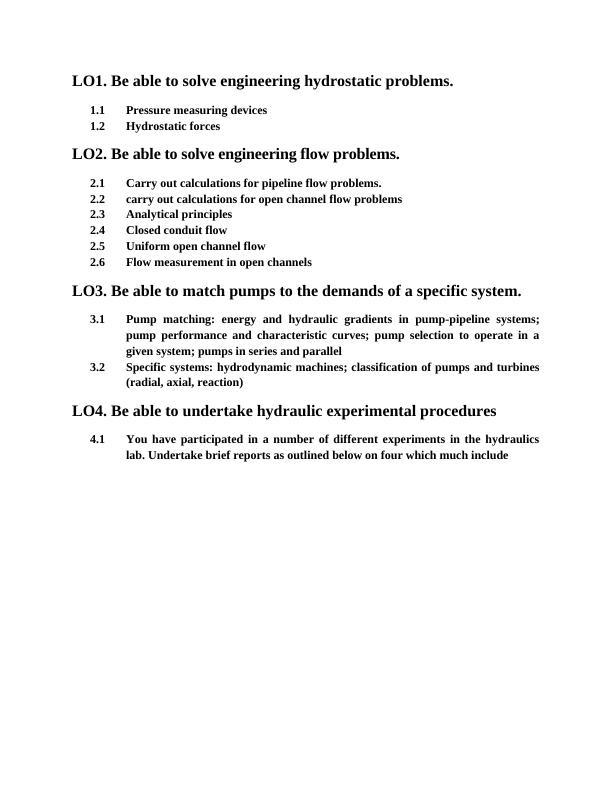
LO1. Be able to solve engineering hydrostatic problems.
Task 1.1. Pressure Measuring Devices.
A) The density of sea water is 1029kN/m3, what would the pressure difference between
the bottom of a freshwater lake of depth 30m and 30m below the surface of the sea?
Assumption – Considering fresh water density to be approx 1000kg/m3
Problem Description
Density of sea water = 1029 kN/m3
Density of fresh water = 1000 kg/m3
Depth of fresh water lake = 30 m
Depth of sea water lake = 30 m
Finding and discussions
Pressure at bottom of fresh water lake =
Pressure at the depth in sea =
Pressure difference
= = = 8534.7 Pa = 8.5347 kPa
Hence, the variation of the pressure of water at the bottom of fresh water lake which is situated
30m under the sea surface is 8.5347 kPa
Conclusion
The major factors that have effect on pressure in fluids are depth of the surface and density of the
fluid. The fluid density and the value of pressure are directly proportional to each other.
Task 1.1. Pressure Measuring Devices.
A) The density of sea water is 1029kN/m3, what would the pressure difference between
the bottom of a freshwater lake of depth 30m and 30m below the surface of the sea?
Assumption – Considering fresh water density to be approx 1000kg/m3
Problem Description
Density of sea water = 1029 kN/m3
Density of fresh water = 1000 kg/m3
Depth of fresh water lake = 30 m
Depth of sea water lake = 30 m
Finding and discussions
Pressure at bottom of fresh water lake =
Pressure at the depth in sea =
Pressure difference
= = = 8534.7 Pa = 8.5347 kPa
Hence, the variation of the pressure of water at the bottom of fresh water lake which is situated
30m under the sea surface is 8.5347 kPa
Conclusion
The major factors that have effect on pressure in fluids are depth of the surface and density of the
fluid. The fluid density and the value of pressure are directly proportional to each other.
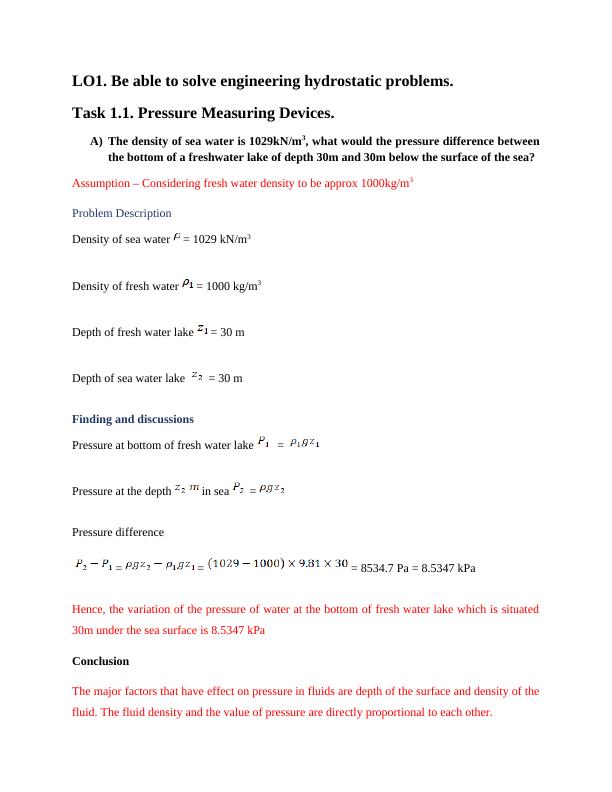
B) What equipment would be used to measure such pressures?
A U-tube manometer is a device that would be helpful for calculating the difference of pressure
among the two points. However, a strain gage pressure transducer is preferred for measuring the
pressure in a water body at a depth of 30m.
Task 1.2. Hydrostatic forces.
A) What is the total force acting on a dam which is 80m long holding back (fresh)
water at a depth of 30m?
Problem Description
Width of dam (w) = 80 m
Depth of water (h) = 30 m
Find force on acting on Dam (F)
Finding and Discussions
Pressure at centroid of dam =
Surface area of dam (A) =
Force on the dam (F) =
A U-tube manometer is a device that would be helpful for calculating the difference of pressure
among the two points. However, a strain gage pressure transducer is preferred for measuring the
pressure in a water body at a depth of 30m.
Task 1.2. Hydrostatic forces.
A) What is the total force acting on a dam which is 80m long holding back (fresh)
water at a depth of 30m?
Problem Description
Width of dam (w) = 80 m
Depth of water (h) = 30 m
Find force on acting on Dam (F)
Finding and Discussions
Pressure at centroid of dam =
Surface area of dam (A) =
Force on the dam (F) =
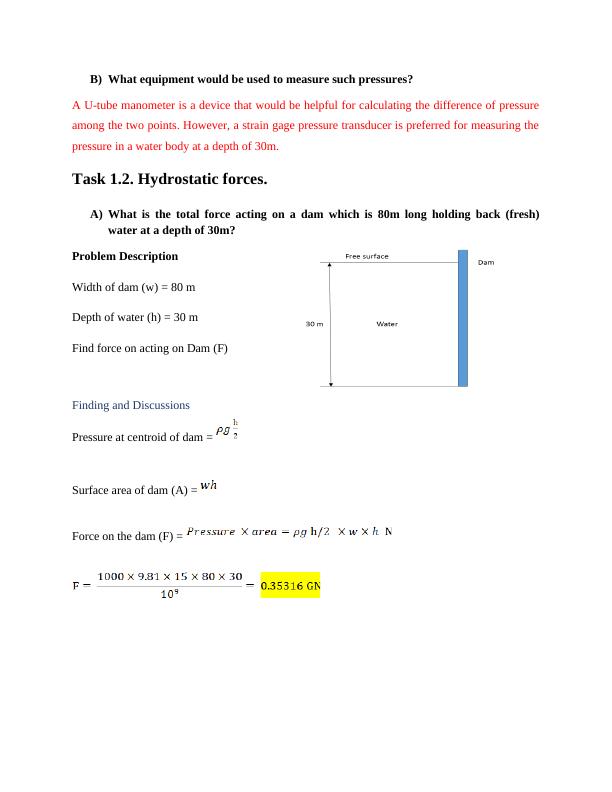
B) If the dam were capable of withstanding a force of 0.422GN at what height above
the bottom of the reservoir would the spill way have to be set?
Problem description
Considering the spill height to be set at= h meter
Force acting upon dam (F)= 0.422GN
Finding and Discussion
Therefore
F =
Therefore h = 32.79 m
Conclusion
The pressure situated at the plane surface’s submerged area and centroid is a measure of the
force acting on the completely submerged plane surface.
the bottom of the reservoir would the spill way have to be set?
Problem description
Considering the spill height to be set at= h meter
Force acting upon dam (F)= 0.422GN
Finding and Discussion
Therefore
F =
Therefore h = 32.79 m
Conclusion
The pressure situated at the plane surface’s submerged area and centroid is a measure of the
force acting on the completely submerged plane surface.

LO2. Be able to solve engineering flow problems.
Task 2.1. Carry out calculations for Pipeline Flow problems.
A) The difference between Laminar or Placid flow on one hand and turbulent flow on
the other is determined by one of two numbers either the Reynold’s number or the
Froude number. Explain the difference between the two and at what value or range
of values does the transition to turbulent flow occur.
Objective: To analyze and evaluate the comparison of the Froude and Reynolds number along
with their significance
Introduction:
Reynolds Number- Reynolds Number can be defined as the ratio between the viscous force and
the inertia force of the fluid flowing which becomes crucial for the fluid flow that in mainly
manipulated by the viscous forces excluding the inertial force of the flowing fluid (for example,
the flow of fluid within the pipe or completely submerged body.)
Reynolds number (Re) = (Inertial force / Viscous force)
Froude Number- Froude Number can be explained as the ratio between the inertial forces of the
fluid to the gravitational force acting on the fluid flowing. The Froude Number gains
significance when the flow of fluid is mainly dominated by the gravitational pull which nulls the
impact of the inertial forces on the fluid such as flow over sluices, channels, spillways, and weirs
(free surface flow).
Froude number = (Inertia force / Gravitational force)
Findings:
Osborne Reynolds had done a tedious experiment in the year 1880 and he came to an inference
that the process of transition of laminar flow to turbulent flow had been largely dependent apart
Task 2.1. Carry out calculations for Pipeline Flow problems.
A) The difference between Laminar or Placid flow on one hand and turbulent flow on
the other is determined by one of two numbers either the Reynold’s number or the
Froude number. Explain the difference between the two and at what value or range
of values does the transition to turbulent flow occur.
Objective: To analyze and evaluate the comparison of the Froude and Reynolds number along
with their significance
Introduction:
Reynolds Number- Reynolds Number can be defined as the ratio between the viscous force and
the inertia force of the fluid flowing which becomes crucial for the fluid flow that in mainly
manipulated by the viscous forces excluding the inertial force of the flowing fluid (for example,
the flow of fluid within the pipe or completely submerged body.)
Reynolds number (Re) = (Inertial force / Viscous force)
Froude Number- Froude Number can be explained as the ratio between the inertial forces of the
fluid to the gravitational force acting on the fluid flowing. The Froude Number gains
significance when the flow of fluid is mainly dominated by the gravitational pull which nulls the
impact of the inertial forces on the fluid such as flow over sluices, channels, spillways, and weirs
(free surface flow).
Froude number = (Inertia force / Gravitational force)
Findings:
Osborne Reynolds had done a tedious experiment in the year 1880 and he came to an inference
that the process of transition of laminar flow to turbulent flow had been largely dependent apart

from flow disturbance and surface roughness, on the value of Reynolds number. For most
practical conditions, the transitional process of laminar flow to turbulent flow for varied types of
flow are summarized as -
Internal flow – Laminar flow, Re ≤ 2300
Transition flow, 2300 ≤ Re ≤ 4000
Turbulent flow, Re ≥ 4000
Flow over smooth flat plate – Laminar Re ≤ 5 * 10^5
Turbulent Re ≥ 5 * 10^5
Flow over circular cylinder or sphere – Laminar, Re ≤ 2 * 10^5
Transition, 2 * 10^5 ≤ Re ≤ 2 * 10^6
Turbulent, Re ≥ 2 * 10^6
Open channel flow – Laminar, Re ≤ 500
Transition, 500 ≤ Re ≤ 2500
Turbulent, Re ≥ 2500
The three types of open channel flow as indicated by the value obtained from Froude number
(Fr) are critical, subcritical or supercritical.
Fr < 1 Subcritical or tranquil flow
Fr = 1 Critical flow
Fr > 1 Supercritical or rapid flow
Mach number and the Froude number are similar for the open channel flow in compressible
flow.
practical conditions, the transitional process of laminar flow to turbulent flow for varied types of
flow are summarized as -
Internal flow – Laminar flow, Re ≤ 2300
Transition flow, 2300 ≤ Re ≤ 4000
Turbulent flow, Re ≥ 4000
Flow over smooth flat plate – Laminar Re ≤ 5 * 10^5
Turbulent Re ≥ 5 * 10^5
Flow over circular cylinder or sphere – Laminar, Re ≤ 2 * 10^5
Transition, 2 * 10^5 ≤ Re ≤ 2 * 10^6
Turbulent, Re ≥ 2 * 10^6
Open channel flow – Laminar, Re ≤ 500
Transition, 500 ≤ Re ≤ 2500
Turbulent, Re ≥ 2500
The three types of open channel flow as indicated by the value obtained from Froude number
(Fr) are critical, subcritical or supercritical.
Fr < 1 Subcritical or tranquil flow
Fr = 1 Critical flow
Fr > 1 Supercritical or rapid flow
Mach number and the Froude number are similar for the open channel flow in compressible
flow.
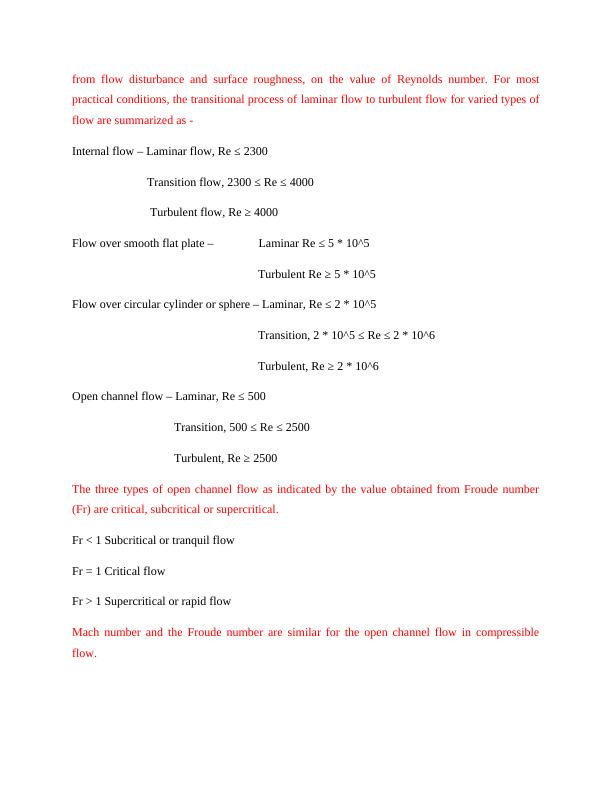
Task 2.2. Carry out calculations for Open Channel Flow problems.
A) Use Darcey Weisbach equation to calculate the friction factor given that the head
loss along a new 10km long straight pipe line is 15 metre when the delivery is10m3s-
1 and the internal diameter of the pipe is 1,400mm.
Objective: To use Darcey Weisbach Equation for calculating the friction factor within the pipe
flow
Approach:
Given data-
Length of pipe, L = 10 km = 10000 m
Head loss, hf = 15 m
Discharge Q = 10 m3/s
Internal diameter D = 1400 mm = 1.4 m
Friction factor (f) = ?
Darcey Weisbach equation - hf = .............eq. (2.2.1)
Vavg = .............eq. (2.2.2)
Cross sectional area Ac = (π/4). D2
Using equation 2.2.1 the value of friction factor ‘f ’ is found to be
A) Use Darcey Weisbach equation to calculate the friction factor given that the head
loss along a new 10km long straight pipe line is 15 metre when the delivery is10m3s-
1 and the internal diameter of the pipe is 1,400mm.
Objective: To use Darcey Weisbach Equation for calculating the friction factor within the pipe
flow
Approach:
Given data-
Length of pipe, L = 10 km = 10000 m
Head loss, hf = 15 m
Discharge Q = 10 m3/s
Internal diameter D = 1400 mm = 1.4 m
Friction factor (f) = ?
Darcey Weisbach equation - hf = .............eq. (2.2.1)
Vavg = .............eq. (2.2.2)
Cross sectional area Ac = (π/4). D2
Using equation 2.2.1 the value of friction factor ‘f ’ is found to be

End of preview
Want to access all the pages? Upload your documents or become a member.
Related Documents
Hydraulic for civil engineeringlg...
|12
|2300
|13
CVEN9625 Fundamentals of Water Engineeringlg...
|5
|864
|325
Hydraulic for Civil Engineering | Reportlg...
|12
|2268
|34
Hydraulics for Civil Engineering Assignmentlg...
|15
|2730
|12
Hydrology and Hydraulics: Venturi Meter, Pump Efficiency, and Hydrographlg...
|5
|590
|360
Fluid Systems and Energy Transfer | Task Reportlg...
|10
|1405
|43
